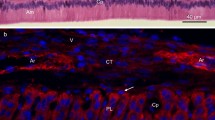Summary
The relationship between the formation of dental enamel and tooth eruption was investigated. Rat mandibular incisor eruption rate was accelerated by maintaining incisors out of occlusion. Rate of eruption, enamel thickness, secretory zone length and matrix breakdown were measured. Eruption rate increased by 120% in experimental teeth but enamel secretion increased by only 90%. There were no obvious differences between control and experimental teeth in final enamel thickness or in the molecular weight distribution of the enamel matrix proteins.
Similar content being viewed by others
References
Berkovitz BKB, Thomas NR (1969) Unimpeded eruption in the root resected lower incisor of the rat with a preliminary note on root transection. Arch Oral Biol 14:771–780
Chiba M (1968) Movement during unimpeded eruption of the position of cells and of material incorporating tritiated proline, in the lingual periodontal membrane of the mandibular incisors of adult male mice. J Dent Res 47:986
Glimcher MJ, Brickley-Parsons D, Levine PT (1977) Studies of enamel proteins during maturation. Calcif Tissue Res 24:259–270
Hiller CR, Robinson C, Weatherell JA (1975) Variations in the composition of developing rat incisor enamel. Calcif Tissue Res 18:1–12
Michaeli Y, Steigman S, Weinreb M, Zajicek G (1982) In: Silberman M, Slavkin HC (eds) Current Advances in Skeletogenesis. Excerpta Medico, Amsterdam, pp 276–283
Michaeli Y, Weinreb MM (1968) Role of attrition and occlusal contact in the physiology of the rat incisor: III. Prevention of attrition and occlusal contact in the non-articulating incisor. J Dent Res 47:633–640
Ness AR (1964) Movement and forces in tooth eruption. In: Staple PH (ed) Advances in Oral Biology. Academic Press, London, pp 33–75
Robinson C, Briggs HD, Atkinson PJ (1981) Histology of enamel organ and chemical composition of adjacent enamel in rat incisors. Calcif Tissue Int 33:513–520
Robinson C, Kirkham J (1985) The dynamics of amelogenesis as revealed by protein compositional studies. In: Butler WT (ed) The Chemistry and Biology of Mineralized Tissues. Ebsco Media Inc., Birmingham, Alabama, pp 248–263
Robinson C, Lowe NR, Weatherell JA (1977) Changes in the amino acid composition of developing rat incisor enamel. Calcif Tissue Res 23:19–31
Shore RC, Moxham BJ, Berkovitz BKB (1982) A quantitative comparison of the ultrastructure of the periodontal ligaments of impeded and unimpeded rat incisors. Arch Oral Biol 27:423–430
Warshawsky H, Smith CE (1974) Morphological classification of rat incisor ameloblasts. Anat Rec 179:423–445
Weber E, Osborne M (1969) The reliability of molecular weight determinations by dodecyl sulphate polyacrylamide gel electrophoresis. J Biol Chem 244:4406–4412
Zajicek G, Bar-Lev M (1971) Kinetics of the inner enamel epithelium in the adult rat incisor 1. Experimental results. Cell Tissue Kinet 4:155–162
Author information
Authors and Affiliations
Rights and permissions
About this article
Cite this article
Robinson, C., Kirkham, J. & Nutman, C.A. Relationship between enamel formation and eruption rate in rat mandibular incisors. Cell Tissue Res. 254, 655–658 (1988). https://doi.org/10.1007/BF00226516
Accepted:
Issue Date:
DOI: https://doi.org/10.1007/BF00226516




